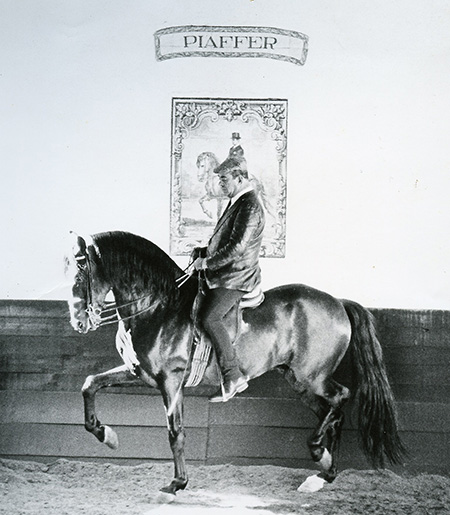
The British dressage rider (and author) Sylvia Loch was long an admirer of the Lusitano horse, and not surprisingly she was enchanted by her time with the most famous modern Portuguese riding master, Nuno Oliveira. Here is her account of her time at his school. This article appeared in The Horse Magazine in the 1980’s…
Illustrations by Jean-Louis Sauvat
Riding under the eye of the Master is both illuminating and inspiring. The indoor school with its attractive Portuguese tiles of classical horsemen from the 18th Century, and a small intimate gallery, and you can smell the scene of the nearby eucalyptus and pine forests as you ride in the tranquility of this unique setting at Quinto do Brego.
Maestro Oliveira teaches from a small rostrum in one corner of the school, where he also operates his beloved opera music… the air is filled with the sounds of Verdi arias. I rode two Lusitano stallions and a Luso-Arab cross whilst there, enjoying both individual instruction as well as participating in work with the Maestro’s extremely talented internal students.
The few days I spent at the Quinta were a time of great value. Having studied the Portuguese classical school over the years and read Mestre Oliveira’s books from cover to cover, it might be inaccurate to say that I learned something new and different. But learn I did. More in that time perhaps, than probably in the last two or three years – who can tell?
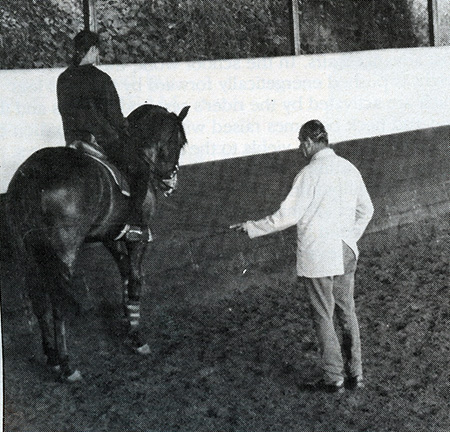
Some people say that learning with the Master seems at first sight to be less intense than that to which they are accustomed. He uses few words; and is unforthcoming with long explanations. But the true student is not disappointed for long. To balance the theories, the Maestro inspires confidence and like a brilliant conductor with a magical baton will produce wonders from the most dubious participants. Then, he makes a short, incredibly to-the-point remark and the mists of uncertainty simply roll away. Like members of an orchestra who simply cannot believe that they have produced those wonderful notes, the riders pat their horses and savour the precious feeling of having performed an advanced movement well.
Nuno Oliveira believes in teaching by feel and practical application. He encourages you to aim for the best. Mistakes are made, you try again, he helps, the mistakes gradually become less and – suddenly you are there! He rightly knows that the serious person will take in far more in a much deeper, more intense way by riding the movements and learning from that practical experience on those patient schoolmaster horses than by long wordy theories.
Back in England, it is only when I get on my own horses again in the manège here at home that I truly appreciate the lasting benefit the Maestro’s effect has made upon me and my riding. He has reaffirmed so much of what I understood in a superficial way before. He has made so simple what I thought difficult.
As for a number of contentious arguments, which were worrying me, he deals with everything in such commonsense light, that everything becomes clear and logical. In my own words, I have outlined seven brief specific points, concerning seven specific subjects,made by the Maestro. Since returning to England from Portugal, I have found these particular points to be extremely helpful to me personally but others might have chosen a totally different set of invaluable hints. I thought it was well worth passing these observations on to readers of The Horse Magazine.
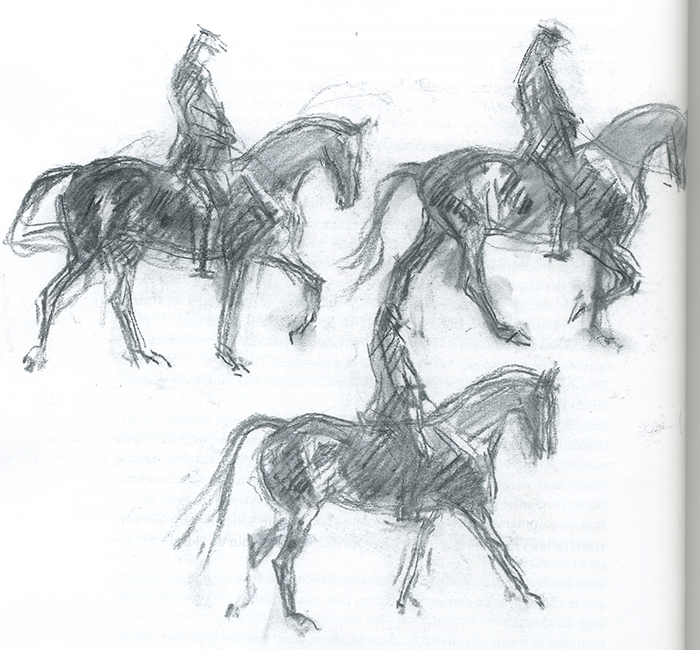
- The Walk. We all spend far too much time in trot. It is the walk which is the basis for all school work and the walk with which we should pre-occupy ourselves. A good collected walk, slow, purposeful and full of impulsion is the foundation for all the collected gaits and finally the most advanced airs. In the school work, the horse’s body weight is pushed energetically forward by the hind legs which are activated by the rider’s seat and leg aids and the head and neck becomes raised with a gentle relaxation of the horse’s jaw as he yields to the rider’s asking fingers.
The rider is wasting his time if he starts work on the trot and canter without first establishing a good walk with the horse active yet submissive and listening. Do not be ashamed to spend hours in perfecting your horse’s walk. You will reap the reward in the improvement of all the other gaits.
COMMENT: I must admit in more recent times, I have concentrated far too much on the trot. Influenced perhaps by the German School, which everyone in English dressage tends to emulate these days. I remember spending hours with two particular Thoroughbred horses in the mistaken idea that by pushing them forward in trot, I would gradually be able to teach them collection and relaxation. What in fact happened was that the more they trotted, the more they got steamed up and we seemed to be getting nowhere.
I see now that if I had spent the same amount of hours in walk, and perfected that before going on to improve the trot and canter, I would have saved myself an awful lot of time later on. I really should have known better because many years ago in Portugal, with the first horse I schooled myself to piaffe, I had indeed spent hours and hours in walk, suppling her on endless circles, teaching her collection, concentrating on roundness in the walk and so on. She therefore was beautifully prepared and made a willing pupil for the most advanced movements, which came so easily to her at a later stage.
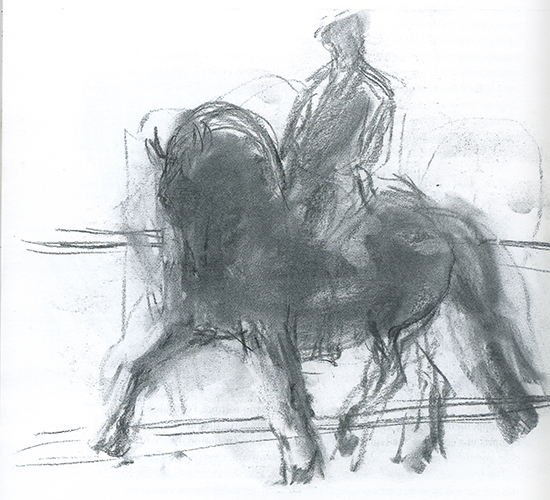
- Shoulder-In: Never underestimate the importance of shoulder-in as a suppling exercise. It is the most important of the lateral exercises and is not employed enough. Do not restrict yourself to making shoulder-in solely up the long sides of the manège; keep the horse happy and interested by riding shoulder-in on the circle, on the short sides, through half circles and up the centre line; from shoulder-in to half pass and back again and so on. As well as shoulder-in towards the centre of the school, practice too the counter shoulder-in facing the wall of the school. The shoulder-in is more easily achieved when the rider’s weight is loaded slightly onto the outside seat bone with the outside leg a little back. Riders are taught to load the inside seat bone but with some horses this may block the movement sideways.
Most riders will ask too much bend with the inside hand. The inside hand should be light in the shoulder-in. Just turn the fingernails of the inside hand uppermost and keep the rein soft. It is the outside hand which leads the horse’s forehand off the track and which dictates the degree of bend coupled of course by the correct use of the inside leg which asks the horse to supple and encurve the girth.
COMMENT: Like the majority of British riders, I had in fact followed the tactics of most British Horse Society recommended publications which teach you to load the inside seat bone in shoulder-in. Since I have been following Nuno Oliveira’s methods, the practice of shoulder-in has for me become much more flowing, active and accurate. It is as though both my horses have breathed a large sigh of relief, and said to themselves ‘thank goodness!’ I am also spending more time in shoulder-in than ever before with very good results.
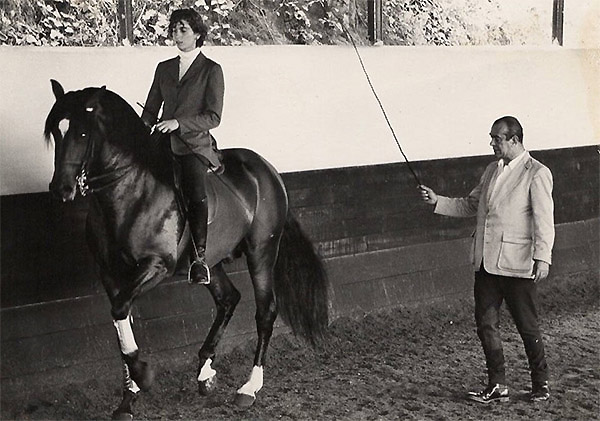 Visitor from the USA, Bettina Drummond working with Nuno
Visitor from the USA, Bettina Drummond working with Nuno
111 Half–Pass: Transitions from the shoulder-in into the half-pass are very beneficial. Also from half-pass to renvers. As the horse becomes proficient and supple in the exercise, practise half-pass on a large circle; as the horse improves, the circle can be reduced in size.
In the half-pass, the rider’s body must remain basically central; it is all too easy to allow the body to lean to the outside, as it is helpful to sit down more on the inside seat bone. The rider’s shoulders must remain parallel to the horse’s shoulders. In between these exercises, check the horse’s straightness by riding down the centre line. Then return to the next stage.
When riding half-pass across the diagonal to the wall, the rider should be using less outside leg by the time he reaches the track.
COMMENT: Much of this is common sense and reaffirmed what I believed but perhaps did not always practise. I know now that I did not vary the exercise sufficiently, thereby keeping my horses’ interest as well as increasing their suppleness. What was particularly thought provoking was the last remark. I have now tried to relax the outside leg more towards the end of the exercise and find that the horse still carries the movement through correctly with the result that on rejoining the track, the whole movement appears altogether smoother and less contrived.
1V Collection and Extension: If too much time is spent teaching the horse to extend before he can collect he will never find it easy to collect and the more advanced movements will be difficult for him. The horse must be taught to round and supple from the beginning. Once you have produced power within collection, it is easier to produce true extension. If however, you concentrate only on extension without first having produced roundness in the horse through the collected exercises, the extension produced will take the form of an unbalanced running movement, rather than true extension from behind. True extension comes only from true collection.
COMMENT: It makes me sad that many pupils in this country are still being brainwashed into keeping their horses in a long low outline for far longer than is necessary. This results in the promotion of flatness instead of roundness, and the very fact that our dressage tests ask for lengthening before some form of rounding and collection is perhaps indicative of the problem. When I look back at some of the horses that I have been asked to bring to collection, I can see why the owners had so many problems. Through too much so-called extension practised too early in the horse’s training, they had ended up with flat horses who found it physically very difficult to supple and round. When this was gently explained,the owner would often say as though to compensate – ‘Ah, but his extension really is brilliant!’ Nine times out of ten, the horse was merely tipped on the forehand and despite an extravagant front leg action, was merely running behind to keep up with the front.
I was so pleased to read the following remark which confirms the above in Jennie Loriston-Clark’s new book – ‘The Complete Guide to Dressage’ (Stanley Paul 1987) – “It is only from true collection that a full extended trot can be achieved.” If only this was appreciated at grass roots level.
V Canter: If too much use is made of the inside leg when asking the horse to canter, it will be very difficult to teach the horse counter canter and later flying change. Better by far to use slightly more outside leg behind the girth to initiate the transition to canter whilst keeping the inside leg quietly at the girth ready to act as a support (or wall) which prevents the hindquarters from straying in. Make the outside leg therefore the positive aid. The horse soon learns to recognize this throughout all the canter departs, changes and so on.
COMMENT: This was exactly what my late husband Henry Loch taught his students in Portugal, no doubt influenced by Maestro Oliveira’s books. Henry’s argument was that the aids should never be confusing to the horse. By giving a clear active aid with the outside leg behind the girth, the balanced horse will engage his outside hind for the bound forward into canter which will put him onto the correct lead. Too much inside leg may confuse the horse, particularly as many students have problems in coordinating the two very separate leg aids required for canter. Therefore to concentrate on the outside leg can be very helpful especially for the student who is schooling his horse himself.
VI Counter Canter: The counter canter is not used nearly sufficiently for preparing the horse for more advanced work. Flying changes should not be taught until the horse can happily continue round the circle in counter canter. Many riders ask for too much bend in the counter canter. This is not necessary. The counter canter is excellent for perfecting the collected canter but it must never be forced since it is a very strenuous exercise. Be content with one or two strides to begin with; then slowly ask for more.
COMMENT: This point very much ties in with the point made above. The counter canter is not easy for many horses, but I do find that for example in counter canter right, keeping the original outside leg asking and positive (ie. the right one) helps the horse enormously to maintain the left leading foreleg.
VII One Sidedness: We hear a lot about horses being one-sided. Most people forget that they are one-sided. If you are right-handed, it is fairly obvious that you will use your right hand more strongly on the right rein than the left. Beware of this all too natural fault as it leads to crookedness in the horse. If you continually seek lightness in your riding, and concentrate on obtaining flexion from your horse from the legs and seat, rather than the hands, you will not only have a pleasanter, more obedient horse to ride, you will also have a straighter, suppler horse.
COMMENT: It is all too easy to forget this very important point. Knowing that my right hand, and probably my right leg, is stronger than my left, I keep reminding myself of this as I ride by making a very conscious effort to keep all the aids as even and as light as possible. Maestro Oliveira uses a very good word to describe the action of the lower leg in the application of aids. Make your legs “electric”, he says. “Light, electric touches!” This says it all and is an invaluable thought to remain in the rider’s mind throughout each schooling session.
In conclusion, let me quote the final sentence from Maestro Nuno Oliveira’s latest book, From an Old Master Trainer to Young Trainers (Howley & Russell, Caramut, Australia): “In all Arts, the artist learns the technique, all the details of that technique, and now he makes his masterpiece which is the result of all that technique with love.”
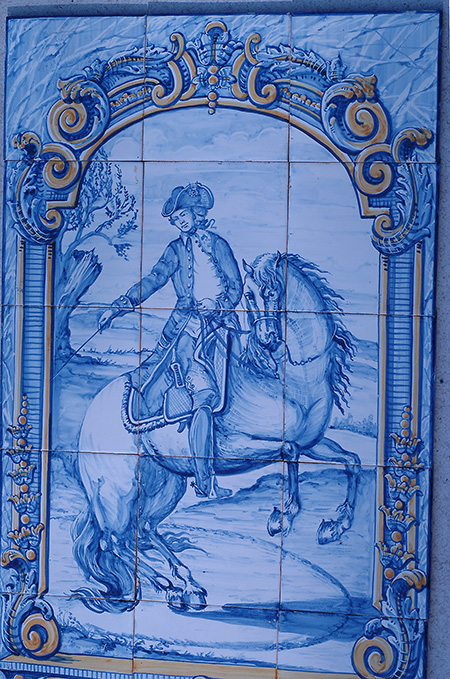


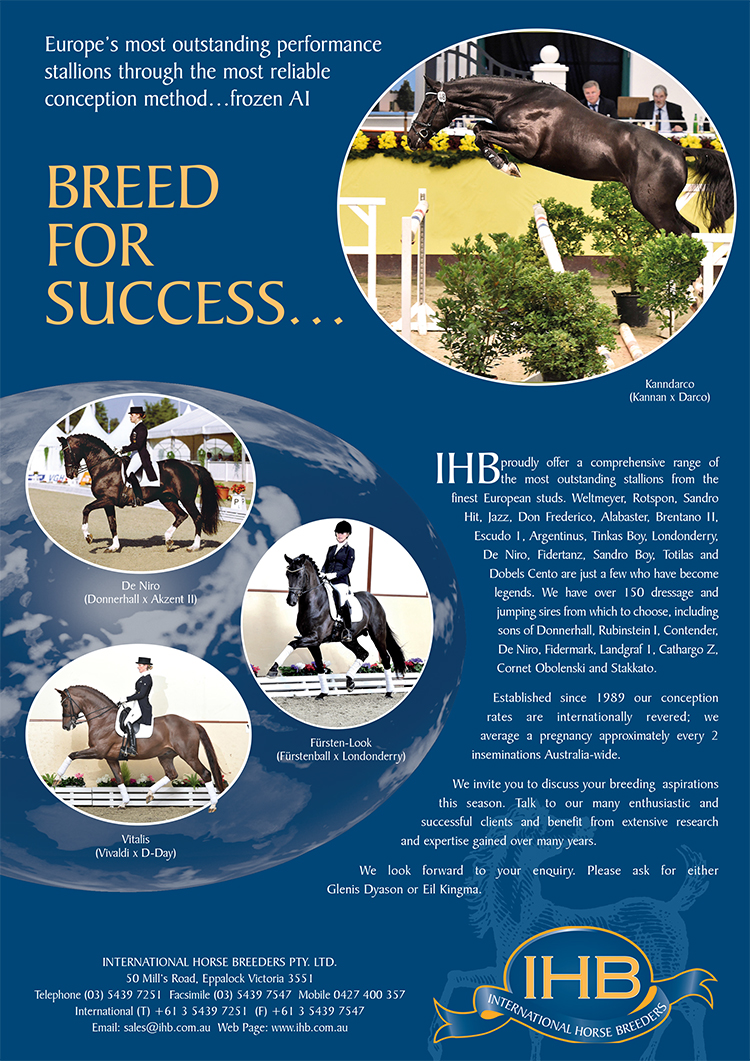
The photo of Bettina shows how to «ride with the hands of a Lady» and how the «cravache» avoids the hand to pull back.
Yes, a wounderfull photo!
I spent marvellous weeks there in 1987 – the horses were beautiful and a delight to ride. Son Juao only taught in French, which was a challenge. I remember practicing canter pirouettes with him – my first try wah one and a half circles before I could come out of it! And the music was perfect, walking down from the village to the stables every moring you could hear it floating out of the valley.